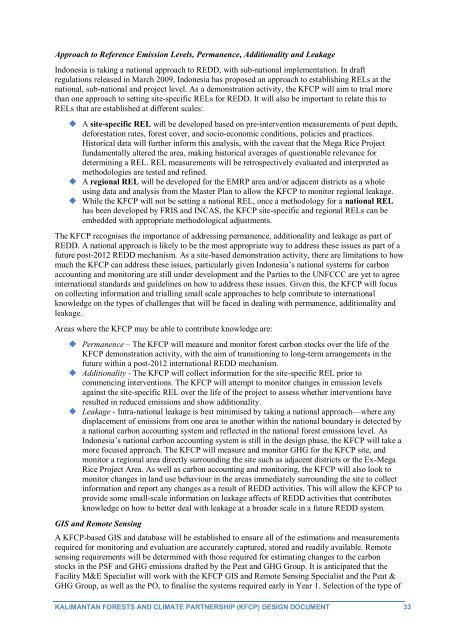Kalimantan Forests and Climate Partnership (KFCP) Design ...
Kalimantan Forests and Climate Partnership (KFCP) Design ...
Kalimantan Forests and Climate Partnership (KFCP) Design ...
Create successful ePaper yourself
Turn your PDF publications into a flip-book with our unique Google optimized e-Paper software.
Approach to Reference Emission Levels, Permanence, Additionality <strong>and</strong> Leakage<br />
Indonesia is taking a national approach to REDD, with sub-national implementation. In draft<br />
regulations released in March 2009, Indonesia has proposed an approach to establishing RELs at the<br />
national, sub-national <strong>and</strong> project level. As a demonstration activity, the <strong>KFCP</strong> will aim to trial more<br />
than one approach to setting site-specific RELs for REDD. It will also be important to relate this to<br />
RELs that are established at different scales:<br />
A site-specific REL will be developed based on pre-intervention measurements of peat depth,<br />
deforestation rates, forest cover, <strong>and</strong> socio-economic conditions, policies <strong>and</strong> practices.<br />
Historical data will further inform this analysis, with the caveat that the Mega Rice Project<br />
fundamentally altered the area, making historical averages of questionable relevance for<br />
determining a REL. REL measurements will be retrospectively evaluated <strong>and</strong> interpreted as<br />
methodologies are tested <strong>and</strong> refined.<br />
A regional REL will be developed for the EMRP area <strong>and</strong>/or adjacent districts as a whole<br />
using data <strong>and</strong> analysis from the Master Plan to allow the <strong>KFCP</strong> to monitor regional leakage.<br />
While the <strong>KFCP</strong> will not be setting a national REL, once a methodology for a national REL<br />
has been developed by FRIS <strong>and</strong> INCAS, the <strong>KFCP</strong> site-specific <strong>and</strong> regional RELs can be<br />
embedded with appropriate methodological adjustments.<br />
The <strong>KFCP</strong> recognises the importance of addressing permanence, additionality <strong>and</strong> leakage as part of<br />
REDD. A national approach is likely to be the most appropriate way to address these issues as part of a<br />
future post-2012 REDD mechanism. As a site-based demonstration activity, there are limitations to how<br />
much the <strong>KFCP</strong> can address these issues, particularly given Indonesia‘s national systems for carbon<br />
accounting <strong>and</strong> monitoring are still under development <strong>and</strong> the Parties to the UNFCCC are yet to agree<br />
international st<strong>and</strong>ards <strong>and</strong> guidelines on how to address these issues. Given this, the <strong>KFCP</strong> will focus<br />
on collecting information <strong>and</strong> trialling small scale approaches to help contribute to international<br />
knowledge on the types of challenges that will be faced in dealing with permanence, additionality <strong>and</strong><br />
leakage.<br />
Areas where the <strong>KFCP</strong> may be able to contribute knowledge are:<br />
Permanence – The <strong>KFCP</strong> will measure <strong>and</strong> monitor forest carbon stocks over the life of the<br />
<strong>KFCP</strong> demonstration activity, with the aim of transitioning to long-term arrangements in the<br />
future within a post-2012 international REDD mechanism.<br />
Additionality - The <strong>KFCP</strong> will collect information for the site-specific REL prior to<br />
commencing interventions. The <strong>KFCP</strong> will attempt to monitor changes in emission levels<br />
against the site-specific REL over the life of the project to assess whether interventions have<br />
resulted in reduced emissions <strong>and</strong> show additionality.<br />
Leakage - Intra-national leakage is best minimised by taking a national approach—where any<br />
displacement of emissions from one area to another within the national boundary is detected by<br />
a national carbon accounting system <strong>and</strong> reflected in the national forest emissions level. As<br />
Indonesia‘s national carbon accounting system is still in the design phase, the <strong>KFCP</strong> will take a<br />
more focused approach. The <strong>KFCP</strong> will measure <strong>and</strong> monitor GHG for the <strong>KFCP</strong> site, <strong>and</strong><br />
monitor a regional area directly surrounding the site such as adjacent districts or the Ex-Mega<br />
Rice Project Area. As well as carbon accounting <strong>and</strong> monitoring, the <strong>KFCP</strong> will also look to<br />
monitor changes in l<strong>and</strong> use behaviour in the areas immediately surrounding the site to collect<br />
information <strong>and</strong> report any changes as a result of REDD activities. This will allow the <strong>KFCP</strong> to<br />
provide some small-scale information on leakage affects of REDD activities that contributes<br />
knowledge on how to better deal with leakage at a broader scale in a future REDD system.<br />
GIS <strong>and</strong> Remote Sensing<br />
A <strong>KFCP</strong>-based GIS <strong>and</strong> database will be established to ensure all of the estimations <strong>and</strong> measurements<br />
required for monitoring <strong>and</strong> evaluation are accurately captured, stored <strong>and</strong> readily available. Remote<br />
sensing requirements will be determined with those required for estimating changes to the carbon<br />
stocks in the PSF <strong>and</strong> GHG emissions drafted by the Peat <strong>and</strong> GHG Group. It is anticipated that the<br />
Facility M&E Specialist will work with the <strong>KFCP</strong> GIS <strong>and</strong> Remote Sensing Specialist <strong>and</strong> the Peat &<br />
GHG Group, as well as the PO, to finalise the systems required early in Year 1. Selection of the type of<br />
KALIMANTAN FORESTS AND CLIMATE PARTNERSHIP (<strong>KFCP</strong>) DESIGN DOCUMENT 33

















